5 เทคโนโลยีหลักที่คุณควรรู้สำหรับระบบอัตโนมัติของโรงพยาบาลที่ประสบความสำเร็จ

สิงคโปร์ – ประเทศที่มีสุขภาพดีที่สุด
คุณรู้หรือไม่ว่าสิงคโปร์เป็นหนึ่งในประเทศที่มีสุขภาพดีที่สุดในโลก? ด้วยอายุขัยที่ 84 ปี (*1) และเป็นหนึ่งในระบบการรักษาพยาบาลที่ดีที่สุดในโลก (*2) ชาวสิงคโปร์จึงมีทั้งชีวิตที่มีสุขภาพดีและความสำเร็จทางเศรษฐกิจในฐานะศูนย์กลางธุรกิจของเอเชีย แรงผลักดันสำคัญของสถานการณ์นี้คือค่าใช้จ่ายภาครัฐที่แข็งแกร่งในภาคการดูแลสุขภาพ รัฐบาลสิงคโปร์ให้ความสำคัญอย่างมากในการให้บริการด้านการรักษาพยาบาลที่มีคุณภาพในราคาย่อมเยาแก่ทุกคนที่อาศัยอยู่ในสิงคโปร์
การมีอายุขัยสูงและอัตราการเกิดต่ำมักนำไปสู่สังคมสูงวัย จากการสำรวจของ GlobalEconomy.com (*3) สิงคโปร์เป็นหนึ่งใน 15 ประเทศที่มีภาวะเจริญพันธุ์ต่ำที่สุดในโลก ดังนั้น สิงคโปร์จึงเผชิญกับความท้าทายเนื่องจากประชากรสูงอายุ (*4) ซึ่งทำให้ยากต่อการบรรจุตำแหน่ง ดังนั้น ระบบอัตโนมัติจึงเป็นส่วนสำคัญในการเอาชนะปัญหานี้ในภาคอุตสาหกรรมต่างๆ ในสิงคโปร์มาหลายปี ภาคการแพทย์ก็ไม่มีข้อยกเว้น
การอ้างอิงระบบอัตโนมัติในสิงคโปร์
-
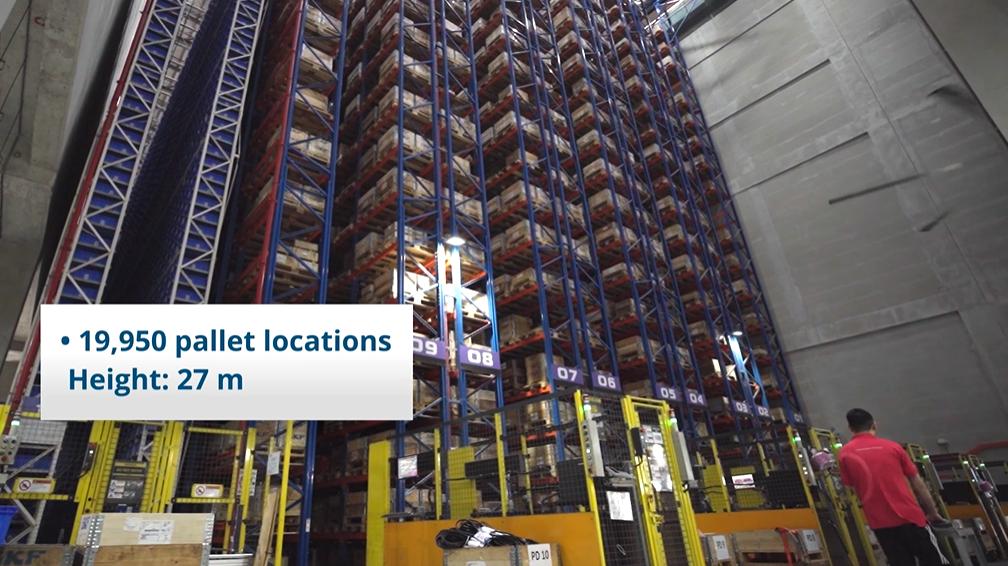
AS/RS ที่ SLS Bearings
-
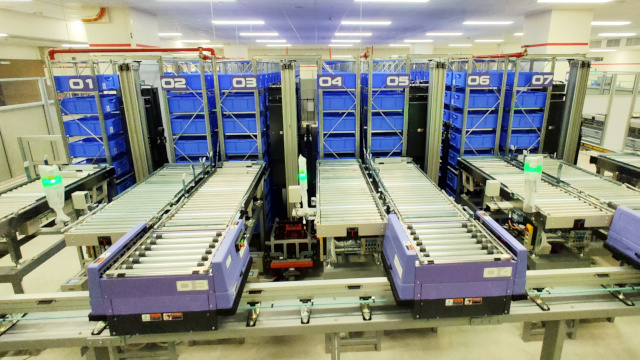
AS/RS พร้อมระบบยานพาหนะที่ร้านขายยาของโรงพยาบาล
-
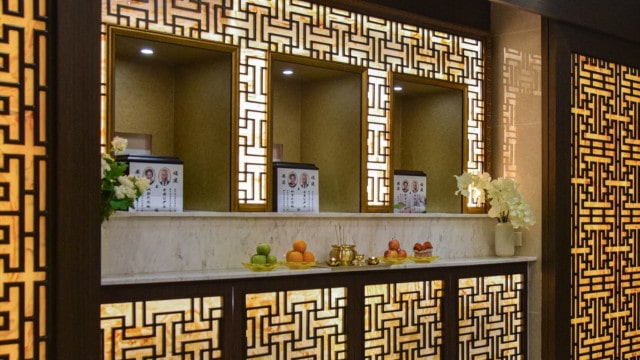
columbarium อัตโนมัติที่ Goldhill Memorial Centre
แนวโน้มหลักของระบบอัตโนมัติที่จำเป็นในโรงพยาบาลสิงคโปร์ ได้แก่ ระบบจัดเก็บและเรียกค้นอัตโนมัติ (AS/RS) การหยิบสินค้าสู่คน (GTP) หุ่นยนต์หยิบสินค้า ยานพาหนะนำทางอัตโนมัติ (AGV) หุ่นยนต์เคลื่อนที่อัตโนมัติ (AMR) และ ระบบควบคุมคลังสินค้า (WCSs) มาดูกันว่าพวกเขาทำให้กระบวนการของโรงพยาบาลเป็นแบบอัตโนมัติและปรับปรุงประสิทธิภาพการทำงานอย่างไร
เทคโนโลยีหลักในระบบอัตโนมัติของโรงพยาบาล
1. ระบบจัดเก็บและเรียกคืนอัตโนมัติ (AS/RS)
เนื่องจากสิงคโปร์มีพื้นที่จำกัด เราจึงต้องเพิ่มประสิทธิภาพการใช้ที่ดินด้วยการจัดหาโซลูชันการจัดเก็บข้อมูลหนาแน่น ดังนั้น AS/RS จึงเป็นโซลูชันยอดนิยมสำหรับโรงพยาบาลที่มีความต้องการพื้นที่จัดเก็บ โดยเฉพาะในแผนกการจัดการวัสดุ (MMD) ร้านขายยา และหน่วยจัดเก็บปลอดเชื้อส่วนกลาง (CSSU)
AS/RS ช่วยให้โรงพยาบาลสามารถปฏิบัติตามข้อกำหนดด้านการจัดเก็บในขณะที่ดำเนินการที่จำเป็นโดยใช้บุคลากรขั้นต่ำเท่านั้น ด้วยเหตุนี้ AS/RS จึงเพิ่มความแม่นยำในการจัดเก็บและการหยิบสินค้า เนื่องจากผู้ปฏิบัติงานลดการทำงานด้วยตนเองลง

2. การเลือกสินค้าต่อบุคคล (GTP)
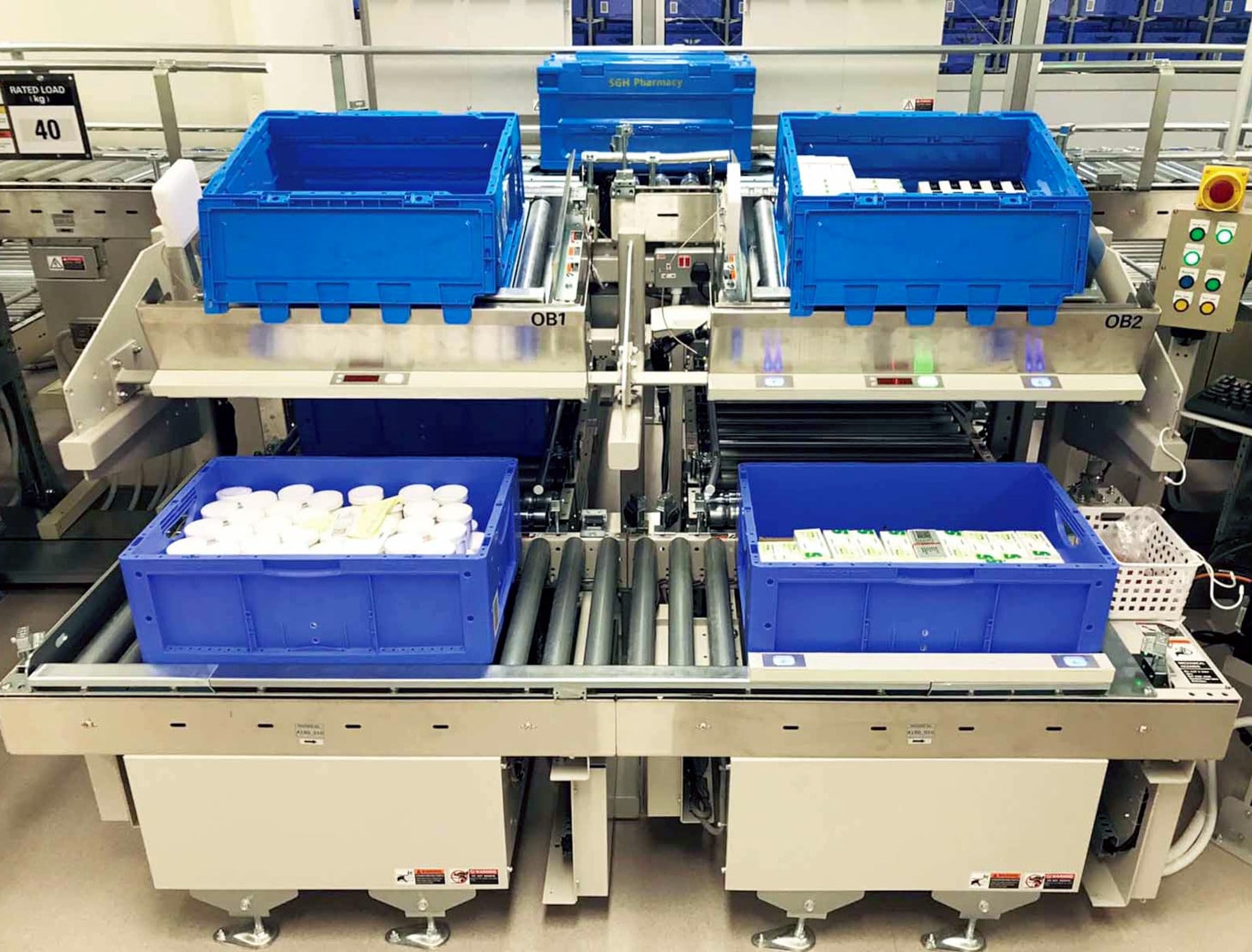
เพื่อเพิ่มประสิทธิภาพการหยิบสินค้าของผู้ปฏิบัติงาน ระบบ GTP จะถูกปรับใช้เพื่อให้ผู้ปฏิบัติงานสามารถหยิบสินค้าจำนวนมากทีละคลื่น แล้วกระจายสินค้าไปยังคำสั่งซื้อแต่ละรายการที่สถานีเดียวกัน สิ่งนี้นำมาซึ่งการปรับปรุงประสิทธิภาพการหยิบสินค้าหลายเท่า เนื่องจากผู้ปฏิบัติงานสามารถรับคำสั่งซื้อได้สูงสุดห้ารายการในเวลาเดียวกัน ระบบ GTP ได้รับความช่วยเหลือจากโมดูล Pick-to-Light ที่แสดงปริมาณและถังที่ถูกต้องในการหยิบ/วาง ซึ่งจะช่วยเพิ่มความแม่นยำและประสิทธิผลของการดำเนินการหยิบสินค้าได้อย่างมาก และส่งผลถึงความปลอดภัยของบริการทางการแพทย์
3. หยิบหุ่นยนต์
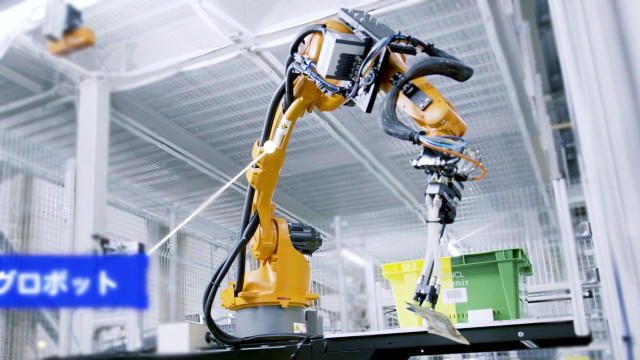
หุ่นยนต์หยิบ สินค้ามักใช้ในโรงพยาบาลเพื่อจ่ายยาที่ร้านขายยา การใช้หุ่นยนต์ช่วยลดการติดต่อของมนุษย์ระหว่างเภสัชกรและผู้ป่วย จากสถานการณ์โควิด การลดการติดต่อจากมนุษย์ถือเป็นข้อพิจารณาที่สำคัญเพื่อลดการแพร่กระจายของโรค
ข้อควรพิจารณาอีกประการหนึ่งในการใช้หุ่นยนต์หยิบสินค้าคือการใช้งานร่วมกับ AS/RS หุ่นยนต์สามารถขนย้ายตู้คอนเทนเนอร์จาก AS/RS ไปยังรถเข็นก่อนที่จะถูกส่งไปยังจุดหมายปลายทาง เช่น ห้องผ่าตัดหรือวอร์ด ระบบอัตโนมัตินี้ช่วยเพิ่มความคล่องตัวในการไหลเวียนของวัสดุ และปรับปรุงประสิทธิภาพการดำเนินงาน
4. Automated Guided Vehicle (AGV) และหุ่นยนต์เคลื่อนที่อัตโนมัติ (AMR)
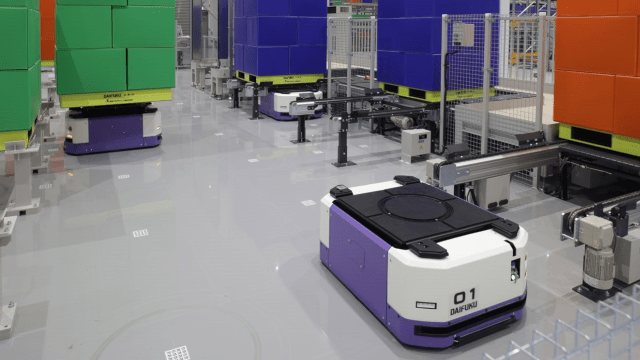
สามารถใช้ AGV และ AMR ในโรงพยาบาลเพื่อช่วยในการเคลื่อนย้ายรถเข็นจากจุดหนึ่งไปยังอีกจุดหนึ่งได้ เช่น เคลื่อนย้ายรถเข็น CSSU จากพื้นที่จัดเก็บไปยังห้องผ่าตัด หรือรถเข็น MMD จากที่เก็บไปยังหอผู้ป่วย สิ่งนี้สามารถช่วยเสริมการทำงานของพนักงานในการเคลื่อนย้ายรถเข็นด้วยตนเองในช่วงเวลาที่มีงานยุ่งหรือเมื่อเผชิญกับการขาดแคลนพนักงาน
5. ระบบควบคุมคลังสินค้า (WCS)
หัวใจสำคัญของระบบขนถ่ายวัสดุอัตโนมัติ (AMHS) คือระบบควบคุมคลังสินค้า (WCS) ซึ่งมีหน้าที่รับผิดชอบในการบูรณาการอุปกรณ์อัตโนมัติทั้งหมดเข้ากับระบบแบ็คเอนด์ของโรงพยาบาล WCS เพิ่มประสิทธิภาพการรับส่งข้อมูลการไหลของวัสดุระหว่างระบบอัตโนมัติต่างๆ และช่วยให้มองเห็นระบบจากมุมสูง อำนวยความสะดวกด้านข้อมูลแบบเรียลไทม์แก่ผู้ใช้ AMHS ระดับต่างๆ ขึ้นอยู่กับประเภทของระบบแบ็คเอนด์ที่แต่ละโรงพยาบาลใช้ WCS อาจจำเป็นต้องเชื่อมต่อกับหลายระบบโดยใช้วิธีการที่แตกต่างกัน แต่ WCS สามารถปรับแต่งได้อย่างมาก ขึ้นอยู่กับประเภทของอุปกรณ์อัตโนมัติและระบบแบ็คเอนด์
บทสรุป
ตามที่อธิบายไว้ข้างต้น มีเทคโนโลยีสำคัญหลายประการที่สามารถนำไปใช้ในการขนส่งของโรงพยาบาลได้ การเลือกโซลูชันที่เหมาะสมที่สุดจะช่วยแก้ปัญหาการขาดแคลนแรงงาน ปรับปรุงประสิทธิภาพการดำเนินงาน และเพิ่มคุณภาพการบริการ หากต้องการเรียนรู้วิธีการนำเทคโนโลยี AMHS ไปใช้จริงในโรงพยาบาล โปรดอ่านกรณีศึกษา Outram Community Hospital หากคุณกำลังพิจารณาที่จะปรับปรุงการไหลเวียนของวัสดุในโรงพยาบาลที่มีอยู่หรือวางแผนสำหรับโรงพยาบาลใหม่ โปรดติดต่อผู้เชี่ยวชาญของ Daifuku ด้วยความเชี่ยวชาญของเราในด้านการจัดเก็บและการขนส่งในภาคการดูแลสุขภาพ เราจึงสามารถออกแบบโซลูชันที่เหมาะสมที่สุดสำหรับความท้าทายในการจัดการวัสดุของคุณได้
อ้างอิง:
- *1Worldometers: อายุขัยของประชากรโลก
- *2การทบทวนประชากรโลก: การดูแลสุขภาพที่ดีที่สุดในโลกปี 2023
- *3The GlobalEconomy.com: อัตราการเกิด - อันดับประเทศ
- *4CNBC: การว่างงานของสิงคโปร์ลดลงใกล้เคียงกับระดับก่อนเกิดโควิด รัฐมนตรีระบุ
Quek Yong Yong

หัวหน้าแผนก ฝ่าย Intralogistics
บริษัท ไดฟูกุ เมคคาโทรนิกส์ (สิงคโปร์) จำกัด
Quek Yong Yong มีประสบการณ์มากกว่า 28 ปีในอุตสาหกรรมการจัดการวัสดุอัตโนมัติ เธอเริ่มต้นอาชีพใน Daifuku ในฐานะวิศวกรซอฟต์แวร์ที่มอบโซลูชันซอฟต์แวร์ที่เน้นด้าน AS/RS ให้กับลูกค้า ปัจจุบันเธอเป็นหัวหน้าแผนกและเป็นผู้นำทีมวิศวกรซอฟต์แวร์ที่พัฒนาโซลูชันซอฟต์แวร์ที่ปรับแต่งได้และให้การสนับสนุนลูกค้าตลอด 24 ชั่วโมงทุกวัน
เกี่ยวกับ Daifuku Mechatronics (สิงคโปร์) Pte Ltd
Daifuku Mechatronics (Singapore) Pte. Ltd. ก่อตั้งขึ้นในปี 1986 โดยมุ่งเน้นด้าน Intralogistics และระบบอัตโนมัติในห้องคลีนรูม ตั้งแต่ก่อตั้งมา บริษัทได้ให้บริการลูกค้าที่พึงพอใจมากกว่า 80 รายในสิงคโปร์ บริษัทให้บริการโซลูชันระบบอัตโนมัติของ Daifuku ตั้งแต่การขาย การออกแบบ การดำเนินโครงการ และบริการหลังการขายตลอด 24 ชั่วโมงทุกวัน ทีมงาน Daifuku Mechatronics ที่มีทักษะจะมอบความอุ่นใจให้กับลูกค้าในการเลือกและใช้โซลูชันของ Daifuku อย่างต่อเนื่อง

